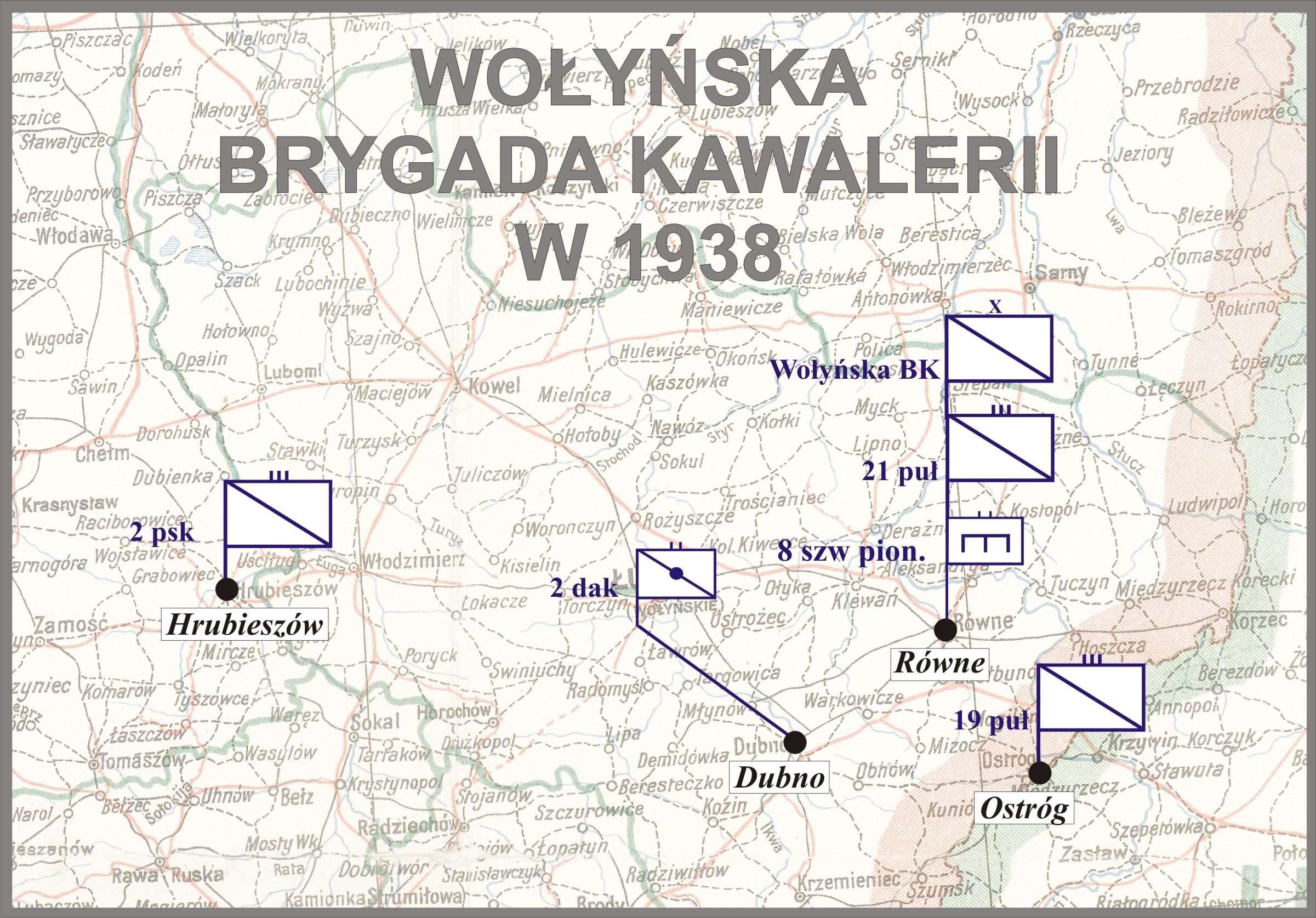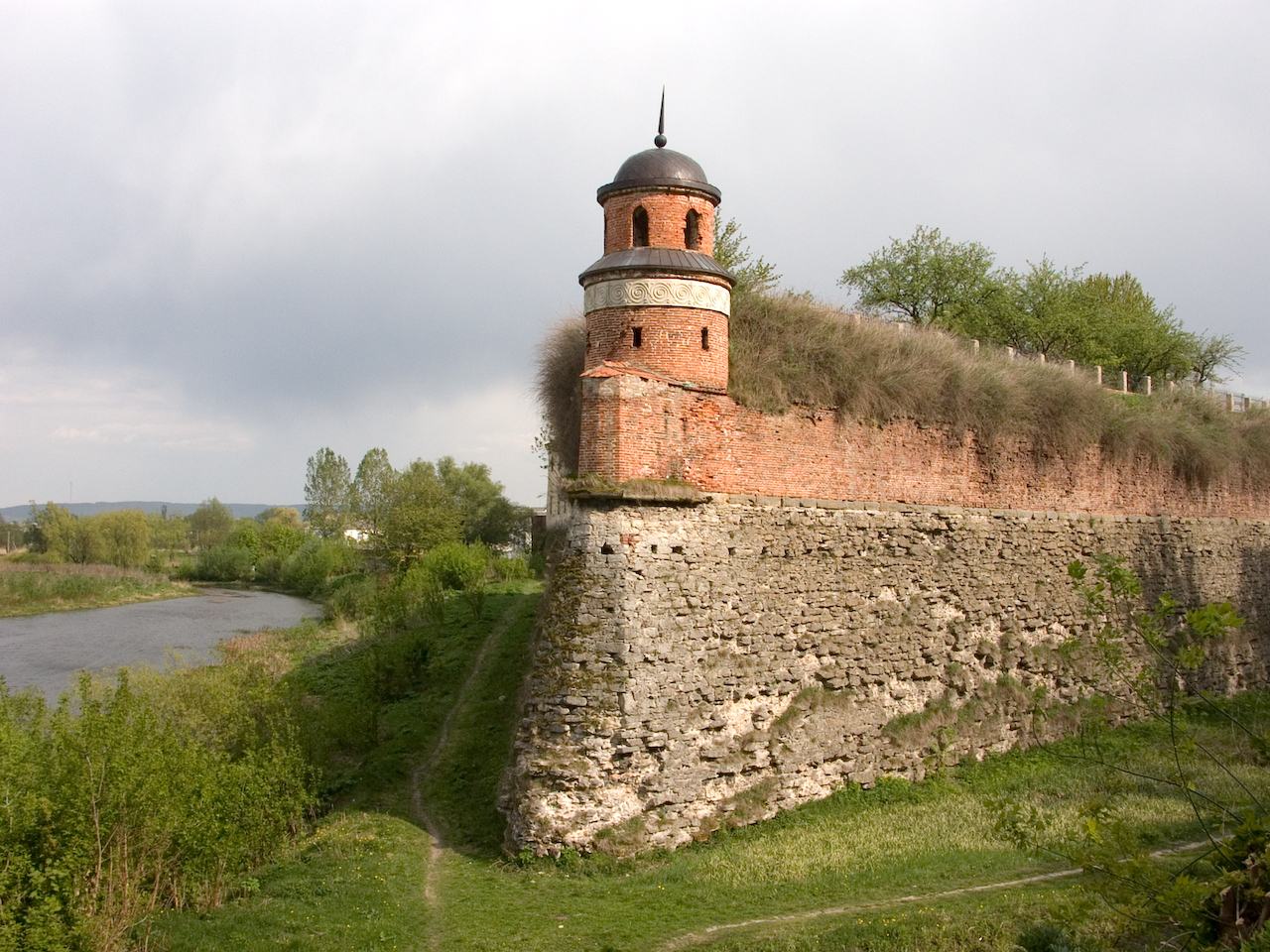|
Volhynian Cavalry Brigade
The Volhynian Cavalry Brigade ( pl, Wołyńska Brygada Kawalerii) was a Polish cavalry brigade, which saw action against the invading Germans during the Invasion of Poland, a part of World War II. Raised from recruits in the area of Wołyń, the division was posted to the Łódź Army. During several desperate counter-attacks, the brigade suffered heavy casualties near Łódź. It was commanded by Colonel Julian Filipowicz. Most notably, the unit took part in one of the first battles of the German invasion of Poland (and thus, World War II), the battle of Mokra. History The Vohlynian Cavalry Brigade was formed on April 1, 1937, out of sub-units of the Równe Cavalry Brigade, and several smaller detachments. Formed out of recruits from the region of Volhynia, the brigade was decentralized and its units stationed in several towns from the region, including Równe, Dubno, Białokrynica and Ostróg by the Horyń. As part of the first wave of the Polish Army, the brigade was fully ... [...More Info...] [...Related Items...] OR: [Wikipedia] [Google] [Baidu] |
Mokra
Mokra may refer to the following places: * Mokra, Łódź Voivodeship (central Poland) * Mokra, Silesian Voivodeship (south Poland) * Mokra, Świętokrzyskie Voivodeship (south-central Poland) * Mokra, Greater Poland Voivodeship (west-central Poland) *Mokra, Lubusz Voivodeship (west Poland) *Mokra, Opole Voivodeship (south-west Poland) * Mokra, Serbia, a village in the municipality of Bela Palanka, Pirot District, Serbia * Mokra, Estonia, a village in Misso Parish, Võru County, Estonia * Mokra, Albania, a region in Albania *, a mountain in Montenegro * Mokra, North Macedonia (''Jakupica''), a mountain range in the central part of North Macedonia See also * Mokra Mountain (other) *Mokra Gora, a village in the municipality of Užice, Zlatibor District, Serbia *Mokra Gora (mountain) Mokra Gora ( sr-cyrl, Мокра Гора, lit='Wet Mountain', ; sq, Malet e Moknës is a mountain on the border between Serbia, Kosovo and Montenegro. It is part of the Accursed Mountains range. ... [...More Info...] [...Related Items...] OR: [Wikipedia] [Google] [Baidu] |
Dubno
Dubno ( uk, Ду́бно) is a city and municipality located on the Ikva River in Rivne Oblast (province) of western Ukraine. It serves as the administrative center of Dubno Raion (district). The city is located on intersection of two major European routes, E40 and E85. The city is estimated to have a population of . It is located within the historic region of Volhynia. In Soviet times it was home to the Cold War facility Dubno air base. The city is also famous for its fortress. History Middle Ages First mentioned in a chronicle of 1100, when it was in possession of Yaroslav the Wise's grandson David of Brest , Dubno was even a seat of local princes for a short period of time. In 1240 the town was raided by the Mongols. In the early 14th century the region was the subject of Polish- Lithuanian rivalry, as a result of which Dubno became part of the latter. However, soon after with the Union of Krewo (1385), it came under Polish influence as part of the Polish-Lithuanian U ... [...More Info...] [...Related Items...] OR: [Wikipedia] [Google] [Baidu] |
Tuszyn
Tuszyn is a small town in Łódź East County, Łódź Voivodeship, central Poland, with 7,237 inhabitants (2020). Climate Tuszyn has a humid continental climate (''Cfb'' in the Köppen climate classification The Köppen climate classification is one of the most widely used climate classification systems. It was first published by German-Russian climatologist Wladimir Köppen (1846–1940) in 1884, with several later modifications by Köppen, notabl ...). References External linksOfficial town website Cities and towns in Łódź Voivodeship Łódź East County [...More Info...] [...Related Items...] OR: [Wikipedia] [Google] [Baidu] |
18th Infantry Division (Wehrmacht)
The German 18th Infantry Division was formed on 1 October 1934 as Infanterieführer III in Liegnitz and renamed ''18. Infanterie-Division'' on 15 October 1935. Mobilized in August 1939 it participated in the Invasion of Poland and in 1940 in the Battle of France. After the French campaign the division was motorized and redesignated 18th Motorized Infantry Division on 1 November 1940 serving on the Eastern Front for the remainder of the war. In June 1943 the division was redesignated 18th Panzergrenadier Division. German 18th Infantry Division *From September 1939 until May 1940 the division fought in Invasion of Poland and then made up part of the occupation force. * From May 1940 until November 1940 the division fought in the Battle of France and then made up part of the occupation force when it was redesignated 18th Motorised Infantry Division. German 18th Motorized Infantry Division Formed 1 November 1940 * Part of the occupation force in France from November 1940 unti ... [...More Info...] [...Related Items...] OR: [Wikipedia] [Google] [Baidu] |
Kamieńsk
Kamieńsk () is a town in Poland, in the Łódź Voivodeship, in Radomsko County. As of 2020, it had 2,703 inhabitants. There is an airport named Kamieńsk-Orla Góra in Kamieńsk mainly used for agricultural purposes. History The settlement was first mentioned in a document dated 1291. It received its town charter in 1374. The settlement lost its status as a town in 1870 but regained it in 1994. Over its history the town has been known as ''Canisko, Camiesko, Kamińsko, Kamiensko'' and ''Kamińsk''. The spelling Kamieńsk has been used since 1918. Jewish community Before the Second World War and the Holocaust the town was a shtetl. Jews began to settle in Kamieńsk in the 18th Century. The earliest Jewish tombstone in the Kamieńsk cemetery dates from 1831. In the 1870s the town selected Israel Stieglitz as its rabbinic leader. He served as its chief rabbi for over 40 years and died in 1921. His son, Pinchas Stieglitz, was selected as his successor and served in that capacit ... [...More Info...] [...Related Items...] OR: [Wikipedia] [Google] [Baidu] |
Widawka
Widawka is a river, located in central Poland ( Łódź Voivodeship, near Bełchatów), a tributary of the Warta. Its length is 95.8 kilometers and its basin's area is 2385 km2. See also *Rivers of Poland Following is a list of rivers, which are at least partially, if not predominantly located within Poland.KSNG (2002–2014)List of Names of Flowing Waters (Wykaz nazw wód płynacych)(PDF file, direct download 1.47 MB), Komisja Standaryzacji Nazw Ge ... Rivers of Poland Rivers of Łódź Voivodeship {{Poland-river-stub ... [...More Info...] [...Related Items...] OR: [Wikipedia] [Google] [Baidu] |
Warta
The river Warta ( , ; german: Warthe ; la, Varta) rises in central Poland and meanders greatly north-west to flow into the Oder, against the German border. About long, it is Poland's second-longest river within its borders after the Vistula, and third-longest including the Oder, that flows also across Czech Republic and Germany.Statistical Yearbook of the Republic of Poland 2017 , p. 85-86 Its |
4th Panzer Division (Wehrmacht)
The 4th Panzer Division ( en, 4th Tank Division) was an armored division in the Army of Nazi Germany. In World War II, it participated in the 1939 invasion of Poland, the 1940 invasion of France, and the 1941 invasion of the Soviet Union. It remained on the Eastern Front, mainly under Army Group Centre, until it was trapped on the coast at Courland in the summer of 1944. It was evacuated by sea and returned to the main front in West Prussia in January 1945. There it surrendered to the Red Army at the end of the war. History Formation The 4th Panzer Division was formed in Würzburg, Bavaria, on 10 November 1938 as the first of a second wave of new armoured divisions in Germany following the creation of the original three tank divisions in 1935. Alongside the 4th Panzer Division the 5th was formed at Oppeln, now Opole in Poland, five days later. Würzburg had previously been the garrison town for the 2nd Panzer Division which had moved its headquarters to Vienna after th ... [...More Info...] [...Related Items...] OR: [Wikipedia] [Google] [Baidu] |
Polish 7th Infantry Division
The 7th Infantry Division (, 7 DP) was the name of several units of the Polish Army. Second Polish Republic The original division was formed on 14 May 1919 near Częstochowa. At that time it consisted of two infantry brigades (13th and 14th), and four infantry regiments (25th, 26th, 11th and 27th), as well as two artillery brigades (7th Light Artillery, 7th Heavy Artillery). The division took part in shielding of the Polish borders during the Polish–Ukrainian War of 1919. During the Polish–Soviet War it was commanded by Col. Szubert and reinforced to three brigades (13th Bde under Herman, 14th Bde under Pogórzelski and 7th Artillery Bde under Luberadzki). It took part in the Battle of the Niemen as part of the Polish 3rd Army. After the war the division was dispersed in several barracks in western Poland, among them in Częstochowa, Piotrków Trybunalski, Lubliniec and Łódź. In 1921, the structure of the division was changed: both infantry brigades were dissolved, and ... [...More Info...] [...Related Items...] OR: [Wikipedia] [Google] [Baidu] |
Operational Group
{{Unreferenced, date=October 2008 Operational Group ( pl, Grupa Operacyjna, abbreviated GO) was the highest level of tactical division of the Polish Army before and during World War II and the invasion of Poland. It was corps-sized, although various Operational Groups varied in size. Operational groups first appeared in Polish tactical scheme during the Polish-Bolshevik War, most probably under the influence of French Military Mission to Poland. After the war they were dissolved. Prior to World War II, the operational groups were recreated. Initially, in March 1939, they consisted only of staffs formed around existing corps commands. According to the Polish mobilization scheme, they were to become mobile reserves of the Polish armies and other major strategic-scale units. One of such groups, the Kutno Operational Group, was planned but never created. Also, in the autumn of 1938, the Independent Operational Group Silesia was created with the purpose of capturing Zaolzie from Czecho ... [...More Info...] [...Related Items...] OR: [Wikipedia] [Google] [Baidu] |
Piotrków Trybunalski
Piotrków Trybunalski (; also known by #Etymology, alternative names), often simplified to Piotrków, is a city in central Poland with 71,252 inhabitants (2021). It is the second-largest city situated in the Łódź Voivodeship. Previously, it was the capital of an independent Piotrków Voivodeship (1975–1998); it is now the capital of Piotrków County. Founded in the late Middle Ages, Piotrków was once a Royal city in Poland, royal city and an important place in Polish history; the first Sejm of the Polish–Lithuanian Commonwealth, parliament sitting was held here in the 15th century. It then became the seat of a Crown Tribunal, the highest court of the Polish–Lithuanian Commonwealth. The city also hosted one of Poland's oldest History of Jews in Poland, Jewish communities, which was entirely destroyed by the Holocaust. The old town in Piotrków features many historical and architectural monuments, including tenements, churches, synagogues and the medieval Piotrków Trybuna ... [...More Info...] [...Related Items...] OR: [Wikipedia] [Google] [Baidu] |
Wiktor Thommée
Wiktor Thommée (1881–1962) was a Polish military commander and a brigadier general of the Polish Army. A veteran of the Great War and the Russian Civil War, he is best known for his command over Piotrków Operational Group and the battle of the Bzura during the Invasion of Poland of 1939. Early life Wiktor Thommée was born 30 December 1881 in Sventiany, Russian Empire (modern Švenčionys, Lithuania), to a Polish family of distant French provenance. After graduating from trade schools in Lida and Dyneburg (modern Daugavpils, Latvia), in 1901 he joined an officers' school in St. Petersburg. In 1904 he graduated and received the grade of second lieutenant, after which he was attached to the Voronezh-based 124th Infantry Regiment. With that unit he took part in the Russo-Japanese War of 1904–1905. Twice wounded, he spent several months in various hospitals, after which he was dismissed from active service for recovery and joined the Trade Institute in Kharkov ... [...More Info...] [...Related Items...] OR: [Wikipedia] [Google] [Baidu] |

